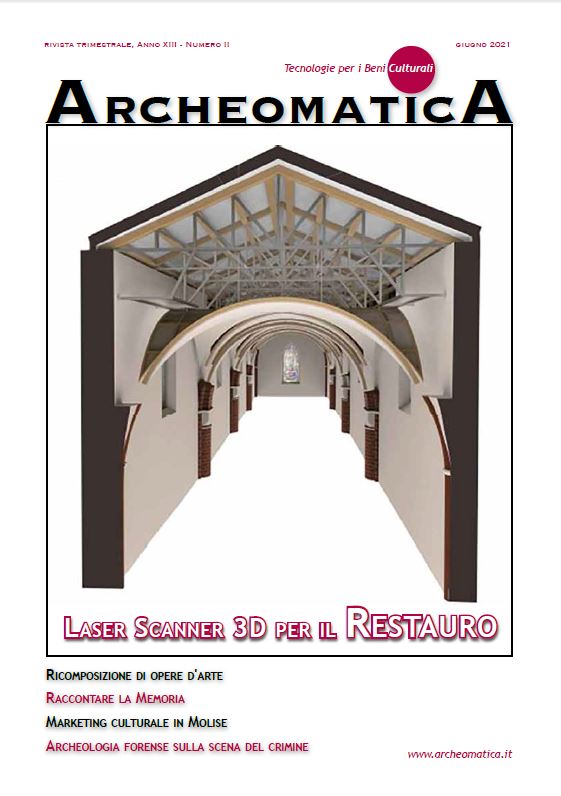Sistema RestArt per la ricomposizione ad alta precisione di opere d'arte lapidee frammentarie
DOI:
https://doi.org/10.48258/arc.v12i2.1805Parole chiave:
sistema meccatronico, ricostruzione virtuale 3D, ricomposizione frammenti lapidei, restauro grandi statueAbstract
The RestArt method is an innovative mechatronic-based procedure,
developed by the architect Nardelli, for high-precision reassembly of stone
fragments intended to improve the restoration of ancient statues
and architectural elements. The procedure comprises high-accuracy
3D laser scanning of two fragments positioned on the RestArt machine.
After virtual reconstruction through best-fitting algorithms, the machine
guides the drilling system for high-precision rods insertion and moves
one fragment to match the other one. The mechanical resistance of
stone specimens reassembled by the RestArt and the traditional methods
was tested by strong motion vibration experiments on shaking table.
Riferimenti bibliografici
Arbacea, L., Sonnino, E., Callieri, M., Dellepiane, M., Fabbri, M.,
Iaccarino Idelson, A. & Scopigno, R. (2013) Innovative uses of 3D digital
technologies to assist the restoration of a fragmented terracotta
statue. J. Cult. Herit. 14(4), 332-345.
De Canio, G., de Felice, G., De Santis, S.,Giocoli, A., Mongelli,
M.,Paolacci, F. & Roselli, I. (2016) Passive 3D motion optical data in
shaking table tests of a SRG-reinforced masonry wall. Earthquakes and
Structures 40(1), 53-71.
Di Pasquale, E., Ju, J.W., Askar, A. & à‡akmak, A.S. (1990) Relation
between Global Damage Indi-ces and Local Stiffness Degradation.
Journal of Structural Engineering, 116(5), 1440-56.
Fioriti, V., Roselli, I.,Tatà¬, A., Romano, R. & De Canio, G. (2018)
Motion Magnification Analysis for Structural Monitoring of Ancient
Constructions. Measurement 129, 375-380.
Gherardini, F., Santachiara, M. & Leali, F.(2018) 3D Virtual
Reconstruction and Augmented Reality Visualization of Damaged Stone
Sculptures. IOP Conf. Series: Materials Science and Engineering, vol.
, 012004.
Jo, Y. H., Hong, S., Jo, S. Y. & Yoon, M. K. (2020) Noncontact restoration
of missing parts of stone Buddha statue based on three-dimensional
virtual modeling and assembly simulation. Herit. Sci. 8(103).
Nardelli, P. (2021) Apparato per la rilevazione, misurazione e
movimentazione per ricomposizioni di oggetti fratturati e relative
a tecnica di utilizzo dello stesso. Brevetto Italiano applicazione n.
, data 1 Febbraio 2021.
Papaioannou, G., Schreck, T., Andreadis, A., Mavridis, P., Gregor, R.,
Vardis, K. & Sipiran, I. (2017) From Reassembly to Object Completion
- A Complete Systems Pipeline. ACM J. Comput. Cult. Herit.,10(2),
Article 8.
Polimeno, M. R., Roselli, I.,Luprano, V., Mongelli, M., Tatà¬, A. & De
Canio, G. (2018) A non-destructive testing methodology for damage
assessment of reinforced concrete buildings after seismic events.
Engineering Structures163, 122-136.
Rasheed, N. A. & Nordin, M. J. (2020) Reconstruction algorithm for
archaeological fragments using slope features. ETRI Journal 42(3), 420-
Rossi, M., Calderini, C., Roselli, I., Mongelli, M., De Canio, G. &
Lagomarsino, S. (2020) Seismic analysis of a masonry cross vault
through shaking table tests: the case study of the Dey Mosque in
Algiers. Earthquakes and Structures 18(1), 57-72.
Dowloads
Pubblicato
Fascicolo
Sezione
Licenza
Gli autori che pubblicano su questa rivista accettano le seguenti condizioni:- Gli autori mantengono i diritti sulla loro opera e cedono alla rivista il diritto di prima pubblicazione dell'opera, contemporaneamente licenziata sotto una Licenza Creative Commons - Attribuzione che permette ad altri di condividere l'opera indicando la paternità intellettuale e la prima pubblicazione su questa rivista.
- Gli autori possono aderire ad altri accordi di licenza non esclusiva per la distribuzione della versione dell'opera pubblicata (es. depositarla in un archivio istituzionale o pubblicarla in una monografia), a patto di indicare che la prima pubblicazione è avvenuta su questa rivista.
- Gli autori possono diffondere la loro opera online (es. in repository istituzionali o nel loro sito web) prima e durante il processo di submission, poiché può portare a scambi produttivi e aumentare le citazioni dell'opera pubblicata (Vedi The Effect of Open Access).





